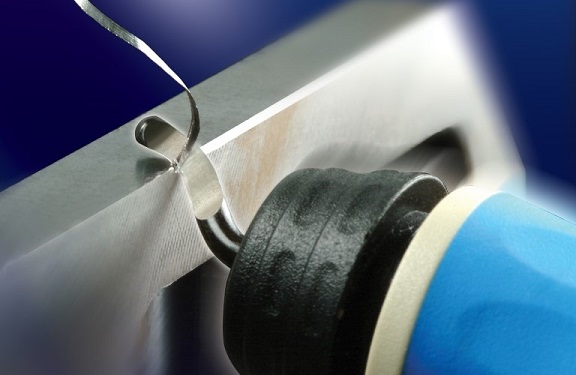In metal manufacturing, precision and quality extend beyond accurate dimensions. Even the most precisely machined or fabricated components often have burrs—small, unwanted projections of material left on the edges after cutting, drilling, milling, stamping, or other processes. These imperfections, although small, can negatively impact functionality, assembly, safety, and aesthetics.
Metal deburring is the process of removing these unwanted burrs to ensure smooth edges, reliable performance, and high-quality finished parts. In precision industries such as aerospace, automotive, electronics, and medical manufacturing, deburring is not an optional step—it is essential.
What Are Burrs and Why Do They Form?
Burrs form when metal is plastically deformed rather than cleanly sheared during machining or cutting. They typically occur at the exit point of a cutting tool or where the material is separated. Common causes include:
- Tool wear causing poor cutting action
- Improper machining parameters such as excessive feed rate
- Material ductility (softer metals like aluminum and copper tend to produce longer burrs)
- Thermal effects during cutting that soften edges
Metal deburring refers to the process of removing unwanted burrs from metal parts. Most of these unnecessary protrusions are accidentally generated, which can affect the correct assembly of parts, affect their performance, and pose safety hazards during use.
Therefore, the main purpose of metal deburring is to eliminate these unnecessary protrusions and make its surface smoother. The deburring process uses various tools and techniques, and is customized according to the shape, material, and surface finish requirements of the parts.
Common types of burrs on metal parts
Burrs are unwanted protrusions, similar to sharp edges. They have different shapes and sizes. In fact, their formation methods also vary depending on the burrs.
Therefore, you must understand the types of burrs in order to choose the correct metal deburring method. The following lists common types of burrs on metal parts.
1. Flip over burrs
Flipped burrs are the most common type of burrs. They are usually formed by cutting tools pushing metal out of the edge without thorough separation. This will cause metal misalignment and folding. This type of burr is common in ductile metals such as aluminum and copper, especially after mechanical processing such as drilling, turning, and milling.
Although flipping burrs are small, they can cause unnecessary friction during assembly, which can hinder the assembly of various parts.
2. Breakout Burrs
The formation of breakout burrs originates from its name itself. Usually, machines or tools can cause material fracture or breakage when they leave their surface. This will cause damage and burrs. They are particularly common in brittle materials such as hard plastics.
Usually, they often appear at the outlet of the hole. Damaged burrs can be very sharp and hard. They can easily cause potential harm and distort the size of components. Therefore, in this situation, it is crucial to use metal deburring.
3. Poisson (compression) burrs
Poisson burrs, also known as compression burrs, are formed due to the lateral deformation of materials. This is driven by compressive force, causing the edges to bulge.
They usually affect softer and more ductile materials, especially in turning and forming processes. They usually appear during the cutting process.
The biggest problem with Poisson burrs is that they are difficult to detect. These burrs are mostly formed internally, which can cause unnecessary stress concentration (such as in specific areas) and affect the tolerance of the entire component. Due to their slight protrusion without obvious fracture, they may cause problems during product assembly.
4. Tear off burrs
When materials break or tear due to cutting tool wear, tearing burrs will be generated. If too much force is applied, it will form large burrs that are difficult to predict and have sharp tips. This situation usually occurs when rough machining operations are used and there is little or no maintenance of the tool.
5. Cut off burrs
Cutting burrs is formed when separating smaller components from larger inventory. This usually occurs when rough machining operations are used or when the tool condition is poor.
Cutting burrs is particularly common in CNC cutting operations, sawing, and manual cutting. They will hinder subsequent manufacturing stages, such as welding.
6. Thermal Burrs
Hot burrs are very common when using hot tools for processing. They are formed due to local melting and solidification, resulting in small, uneven bead like or spherical objects at the edges.
The importance of metal deburring
Metal deburring can provide safety assurance for all personnel involved in the manufacturing process, including workers, operators, and consumers. Dealing with metal parts with sharp edges or unnecessary protrusions poses a significant risk of scarring and injury. Removing burrs from the production, transportation, and final assembly of the system using this component can reduce the risk of injury to all relevant personnel.
In addition, when metal components pass through other machines during the manufacturing process, metal deburring also helps prevent wear and tear from other machines. In addition, it can also make the final product look better. It can also effectively adhere uniform paint and other coatings to the surface.
By making the final product safer and better performing, metal deburring can also help companies avoid any possible litigation and legal consequences related to component failures or potential injuries.

Common Metal Deburring Methods
1. Manual Deburring
Using hand tools such as files, scrapers, deburring knives, or abrasive pads.
Advantages: Low cost for small batches, high flexibility.
Disadvantages: Labor-intensive, inconsistent results for high-volume production.
2. Mechanical Deburring
Using machines or abrasive tools to remove burrs, including:
Grinding and Sanding – For flat or easily accessible surfaces.
Abrasive Belt Machines – Ideal for sheet metal and flat components.
Wire Brushing – Removes fine burrs and cleans edges.
3. Vibratory and Tumbling Deburring
Parts are placed in a vibrating or rotating container with abrasive media that polishes and smooths edges.
Advantages: Handles large batches, consistent finish.
Disadvantages: May not reach deep recesses or complex geometries.
4. Thermal Deburring (TEM)
Burrs are burned away using a controlled explosion of combustible gas inside a sealed chamber.
Advantages: Reaches internal and inaccessible burrs.
Disadvantages: High equipment cost, requires safety protocols.
5. Electrochemical Deburring (ECD)
Uses an electrolytic process to dissolve burrs selectively without affecting the base material.
Advantages: Precise, suitable for delicate parts and internal features.
Disadvantages: Specialized equipment required, chemical handling necessary.
6. Laser Deburring
High-energy laser beams remove burrs through localized melting and vaporization.
Advantages: Contact-free, highly precise.
Disadvantages: High cost, mainly for specialized applications.
Conclusion
Metal deburring is not just a finishing step—it is an essential part of producing safe, reliable, and high-quality components. Whether it’s manual deburring for prototypes or automated deburring for mass production, choosing the right method ensures functionality, improves appearance, and enhances overall product quality.
For manufacturers aiming for precision, safety, and superior aesthetics, implementing an efficient deburring strategy is a smart investment that pays off in reduced defects, improved performance, and higher customer satisfaction.



